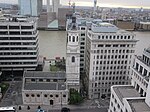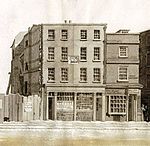The Monument to the Great Fire of London, more commonly known simply as the Monument, is a fluted Doric column in London, England, situated near the northern end of London Bridge. Commemorating the Great Fire of London, it stands at the junction of Monument Street and Fish Street Hill, 202 feet (62 m) in height and 202 feet west of the spot in Pudding Lane where the Great Fire started on 2 September 1666. Constructed between 1671 and 1677, it was built on the site of St Margaret, New Fish Street, the first church to be destroyed by the Great Fire. It is Grade I-listed and is a scheduled monument. Another monument, the Golden Boy of Pye Corner, marks the point near Smithfield where the fire was stopped.
The Monument comprises a Doric column built of Portland stone topped with a gilded urn of fire. It was designed by Christopher Wren and Robert Hooke. Its height marks its distance from the site of the shop of Thomas Farriner (or Farynor), the king's baker, where the blaze began.
The viewing platform near the top of the Monument is reached by a narrow winding staircase of 345 steps. A mesh cage was added in the mid-19th century to prevent people jumping to the ground, after six people died by suicide there between 1788 and 1842.Three sides of the base carry inscriptions in Latin. The one on the south side describes actions taken by King Charles II following the fire. The inscription on the east side describes how the Monument was started and brought to perfection, and under which mayors. Inscriptions on the north side describe how the fire started, how much damage it caused, and how it was eventually extinguished. The Latin words "Sed Furor Papisticus Qui Tamdiu Patravit Nondum Restingvitur" (but Popish frenzy, which wrought such horrors, is not yet quenched) were added to the end of the inscription on the orders of the Court of Aldermen in 1681 during the foment of the Popish Plot. Text on the east side originally falsely blamed Roman Catholics for the fire ("burning of this protestant city, begun and carried on by the treachery and malice of the popish faction"), which prompted Alexander Pope (himself a Catholic) to say of the area:
The words blaming Catholics were chiselled out with Catholic Emancipation in 1830.The west side of the base displays a sculpture, by Caius Gabriel Cibber, in alto and bas relief, of the destruction of the City; with Charles II and his brother, James, the Duke of York (later King James II), surrounded by liberty, architecture, and science, giving directions for its restoration.It gives its name to the nearby London Underground station, Monument.












